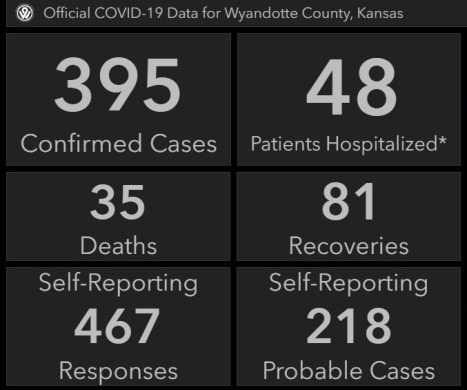
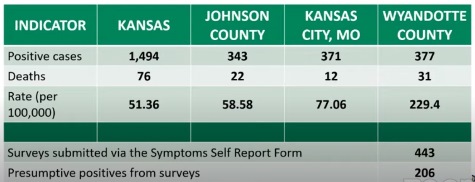
More COVID-19 testing is planned in Wyandotte County, according to Unified Government Health Department officials.
Terrie Garrison, interim director of the UG Health Department, said Wyandotte County had the highest number of positive COVID-19 cases in the metro area and also in the state of Kansas. She discussed COVID-19 during the Unified Government Board of Health meeting Thursday evening.
On Thursday, Wyandotte County had 377 cases compared to the state’s 1,494 cases, and 31 deaths compared to the state’s 76 deaths. The state had 51.36 cases per 100,000 population. Wyandotte County had 229.4 cases per 100,000 population, Garrison said.
Johnson County, to the south with four times the population as Wyandotte County, had 343 cases and 22 deaths, with a rate of 58.58 cases per 100,000 persons.
Kansas City, Missouri, a larger community, had 371 positive cases and 12 deaths, with a rate of 77.06 per 100,000 population, she said.
Garrison said even if Wyandotte County subtracts the 113 cases at Riverbend, it will still be about 150 cases per 100,000, a very significant rate for the community, and much more than surrounding communities.
Wyandotte County began a self-reporting survey on its COVID-19 website for individuals to make self-reports. Those who did so received a return call from a health professional, and information about what they need to do to protect themselves. To date, 443 persons responded and took a survey, she said. Of those, 206 were determined by the Health Department to be probable cases, she said. Some of them have been tested and were positive, she added.
Garrison said there are several strategies the Health Department is using to determine how widespread the COVID-19 infection is here, and to squelch further infections within the county.
Testing here began with a safety net provider, Dr. Sharon Lee, who stepped up and began a community testing site. Then the Health Department began a testing site at its parking lot.
The Health Department also is using communications strategies to get information to the public, and community engagement to address disparities, and social distancing is continuing, she said.
Testing being expanded
The Health Department has been testing for two full weeks at the Health Department parking lot, according to officials. UG clinical staff and resident physicians from the University of Kansas Family Medicine Department are helping take the tests.
By today or Monday, about 2,000 test kits will be ready to go in an effort to ramp up testing capacity, according to Dr. Erin Corriveau, deputy medical officer for the Health Department.
Testing will take place from 1 to 5 p.m. Monday through Friday, and results should be back within 24 hours, she said.
The UG provided $50,000 in funding that allowed the Health Department to purchase tests, which are being offered free to Wyandotte County residents, she said.
The Health Department is beginning relaxed criteria for testing, which had been prioritizing first responders and those exposed to known positive cases. Now anyone in Wyandotte County with symptoms that may be related to COVID-19 can be tested if they had symptoms in the last 48 hours, she said.
Also, the Health Department will begin accepting walk-up or drive-up patients for testing. Previously, the patients had to call 311 or use the UG’s self-reporting tool at https://alpha.wycokck.org/Coronavirus-COVID-19-Information.
The Health Department has received help from KU Medical residents for personnel for testing, and has received some personal protective equipment from the state. It is putting together test kits rom purchased materials.
The Health Department has done 150 tests to date, with 37 positive test results and 25 percent positive, she said. This is one percent or less of the population. They would eventually like to see about 10 percent, with some private funding, but might not be able to do that many tests, according to health officials.
As the Health Department starts health equity work, they will be reaching out beyond the parking lot of the Health Department and beyond the other site to other neighborhoods in Wyandotte County, she said. They will announce the new site or sites on Monday.
A testing program will partner with Vibrant Health Care and will test at community sites, she said. The program hopes to reach more minorities, including Latinos, she said.
In a week or two, the Health Department would like to do more testing of people without symptoms in a representative community sample, with support from private company donations, she said.
Cluster outbreaks in Wyandotte County
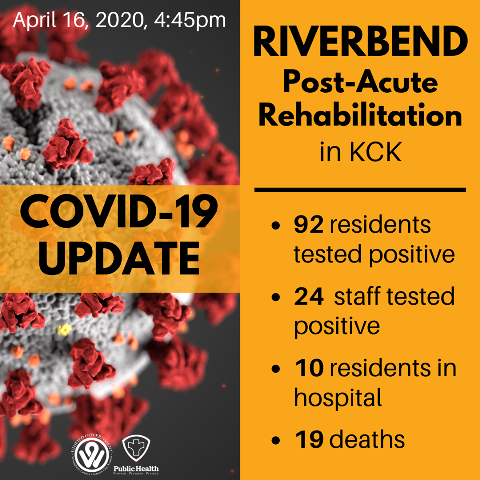
Health Department staff reported that they have been tracing contacts of the 376 positive COVID-19 cases in Wyandotte County.
Any contacts they identify are required to quarantine at home for 14 days, according to Health Department staff. A team of 24 investigators that included KU Medical student and UG Health Department employees are working on contact tracing.
The biggest cluster of COVID-19 outbreaks in Wyandotte County has been the Riverbend post-acute rehabilitation center, with 116 cases and 19 deaths, according to Elizabeth Groenweghe, chief epidemiologist at the UG Health Department. It was also the largest outbreak in the state of Kansas. See https://wyandotteonline.com/four-more-deaths-reported-at-riverbend-facility-bringing-death-toll-to-19/.
Kansas Department of Health and Environment epidemiologists also are working with the Health Department to monitor the outbreak, according to health officials.
One of the biggest clusters also was in Wyandotte County, at the Eastern Kansas Ministers Conference held March 16-22 at the Miracle Temple Church, according to Groenweghe.
The church conference resulted in 44 cases and five deaths across Kansas, including some in different counties, as people came from throughout the state to attend the conference, she said. Sixteen of the cases are residents of Wyandotte County.
Other outbreaks in Wyandotte County included the Rising Star Baptist Church gala on March 14, which produced seven cases and one death, according to Groenweghe.
Groenweghe said other clusters in Wyandotte County included:
• Delaware Highlands Assisted Living, three cases among employees;
• Liberty Fruit, three cases among employees;
• Bonner Springs Walmart, three cases among employees;
• Kellogg’s bakery in Kansas City, Kansas, three cases originally, now up to six cases.
With the clusters, the Health Department reaches out to the workplace and the KDHE, making sure that they are putting control measures into place, she said. They also require anyone in contact with positive patients to be quarantined for 14 days, she said.
Communications
The Health Department has been working on getting information to the public about topics such as religious gathering recommendations, said Janell Friesen, public information officerfor the Health Department. It also has been posting updates on the Riverbend facility numbers, she said.
They also answered questions and provided information on the stay-at-home order, she said. The order was extended at the state level this week to May 3.
As they ramp up testing, they are trying to get the word out as to how people can get tested, she said.
They also released data on race and ethnicity, and talked about how they are joining with other organizations to address health equity, she said.
Communication has been through various methods, including through social media, through the media, through the UG email newsletter, through the UG print newsletter next week, through fliers and posters, and through videos, she said.
Most materials are being produced in both English and Spanish, she added. Mayor David Alvey said he had been on several podcasts, Facebook Live and radio stations offering information in Spanish.
Health equity and racial disparities in COVID-19 here
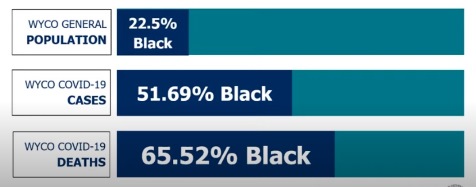
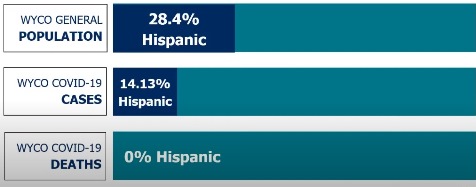
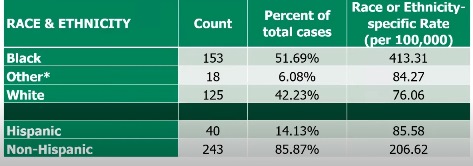

Juliann Van Liew, who manages operations in the Health Department, said about 22.5 percent of the population identifies as black, while 51.69 percent of the COVID-19 cases here identified as black, and 65.52 percent of the Wyandotte County COVID-19 deaths identified as black. This represents about 80 percent of the cases for which data has been retrieved, and the numbers will be updated as they receive more information.
“This is incredibly shocking and concerning to all of us,” she said. Disparities that have existed for a long time in the community only seem to intensify during a crisis such as the pandemic, she noted.
This follows a national trend, she said.
This community experiences higher rates of co-morbidity, which puts them at higher risk, she said, and also are less likely to have health insurance, which also puts them at higher risk.
The Hispanic population makes up about 28.4 percent of the general population here, but are only 14.13 percent of the positive cases, with zero deaths.
“We don’t think that this is because there is a lower rate among the Hispanic population. We actually think it’s due to a lack of access to testing and some trust issues with where testing is being offered,” Van Liew said. It is an area where they need to do better, she added.
She said a COVID-19 Health Equity Task Force has been convened by the Health Departmetn with representation from high-risk populations.
The task force met earlier this week and generated ideas about why they are seeing what they are and what to do about it.
They identified a need for pop-up testing, including going to different locations. The Health Department will partner with Vibrant health care to do the testing, she said. Also, the task force encouraged non-governmental communication and testing, to deal with trust issues.
They also discussed providing incentives for testing, such as giving away hand sanitizer to those who get tested.
In addition, the task force has worked with MoreSquared to get the local community engaged, she said, and receive information on testing.
In addition, there is an idea to launch a health care COVID-19 information line that would link to community health resources and social services, she said.
UG Commissioner Harold Johnson said a strategy is needed to better engage affected communities, particularly the African-American community.
“That seems an alarming percentage,” he said about the rate of cases and deaths among African-Americans. He asked to pinpoint specifically where the positive persons lived and go more into the neighborhoods where the positive cases are.
Commissioner Christian Ramirez asked about better services and communication with the Hispanic community.
“We agree it’s alarming and unacceptable,” Dr. Allen Greiner, chief medical officer of Wyandotte County, said. They are mapping the cases and will be trying to target pop-up testing. They are working to build trust, and have a group of faith leaders and task force members involved. He would like the community to be a national model of how they reverse this trend.
‘Social distancing is having an impact’
According to Dr. Greiner, Gov. Laura Kelly extended her stay-at-home order this week until May 3, and Wyandotte County will be under the governor’s order, as it supersedes the local order, which runs through April 24. The stay-at-home order will be in effect through May 3 under the state of Kansas.
“We believe that social distancing is having an impact, based on the data we’re seeing, especially the hospital utilization data,” Dr. Greiner said. “If we were going to have the kind of exponential rise in cases, where cases were doubling or tripling over a couple, three days, we would be seeing a lot of hospitalizations than we are seeing, although it’s still unclear where the statistics are going on this. We are in favor of this continuing, and probably continuing beyond May 3.”
“We feel like compliance has been very good on this,” he said.
The Kansas City, Kansas, Police Department has visited only four businesses more than once, and most calls were cleared up through conversations with the Police Department, according to Dr. Greiner.
The police received fewer than five calls a day, according to Dr. Greiner.
One staff member in the Wyandotte County Jail was confirmed positive for COVID-19, according to the Health Department, with no inmates positive. They are continuing to monitor it all closely, he said.
Local health officers across Greater Kansas City metro area held a meeting Tuesday and agreed to recommend an extension of the stay-at-home order until May 15, he said.
In the metropolitan area, they believe the peak of cases, the days with the most new cases reported, will be April 28 or 29, Dr. Greiner said. Their working hypothesis, based on an incubation period that could be as much as 14 days, is to go beyond the peak for a full 14 days to feel assured the curve of new cases and the number per day is actually going down, he said.
The state of Kansas peak is estimated to be before April 28 and 29, he said, which is why the governor’s order only went through May 3.
There will be a lot more data available in the next seven to 10 days, he said.
“Our governmental entity is not ready to call a date on this,” Dr. Greiner said. “The health officers did call a date in our (Mid-America Regional Council) press release.”
Kansas City, Missouri, did make an announcement with the extension of the stay-at-home order through May 15, but Wyandotte County is not ready to do that, he said.
“We’re working very closely with the hospitals in the county,” Dr. Greiner said. “We’ve got multiple researchers at KU Med Center that are meeting on a daily basis, redoing models, crunching numbers trying to figure out exactly how we ought to time this. We do have to see that decline in deaths, we want to see a decline in the total patients hospitalized, the number of total patients in ICUs, the number of patients on ventilators.”
By expanding community testing, it will help them have a better sense of what’s going on out there, and plan educational approaches and tracing approaches to reduce spread, he said.
“We plan to continue that,” he said. “We do not want to back off the contact tracing and the quarantine and isolation recommendations that go along with that.”
It would be ideal to test 10 percent of the population, he said, but if they could test 2 to 3 percent of the population, around 4,300 people, he feels they could get a reasonable idea of what is going on in the community.
That would require about 180 or more tests a day, he said, which would take about 25 days.
“We do believe we will have partners coming on line soon that will offer us free test kits and free test processing,” Dr. Greiner said. The UG has contributed $50,000 to get testing started. Those other partners include the KU Medical Center and local business partners.
A reopening would have to be gradually completed, he said. The full plan is not in place yet, but a team is working on it to try to find best practices, he added. It may include what size of business could reopen. Also it may have recommendations on the risk of activities outdoors versus indoors.
“We also have to be prepared for a second wave,” Dr. Greiner said. With the SARS epidemic, they saw a second wave in Canada, almost as big as the first wave, he added.
“We want to have a plan in place in case that does occur,” he said. They might have to go back and initiate some policies and restrictions in case that occurs, he added.
Dr. Greiner also said the CDC recommends persons wearing face masks when they leave homes, especially within 6 feet of another person.
Financial and social support is available through the UG COVID-19 website at https://alpha.wycokck.org/Coronavirus-COVID-19-Information, he said.
Although the Health Department doesn’t know for sure the actual infection rate, there is an estimate based on previously published information on COVID-19 that it would be about 100 to 130 times the number of tested positive cases, he said. In Wyandotte County, this could be 36,000 to 46,800 persons, he added.
Many of those individuals may be asymptomatic or have mild symptoms that they don’t recognize as COVID-19, he added. There are reports that up to 86 percent of those infected have no symptoms or very mild symptoms.
While those individuals with mild symptoms may not need to be tested, they need to practice universal precautions, including wearing a face mask, which protects others, he said.
More information is available on the video of the UG Board of Health meeting, available on YouTube at https://www.youtube.com/watch?v=gi58K7xsXdU.
The UG’s COVID-19 webpage is at https://alpha.wycokck.org/Coronavirus-COVID-19-Information.
The Kansas COVID-19 resource page is at https://govstatus.egov.com/coronavirus.
The CDC COVID-19 page is at https://www.cdc.gov/coronavirus/2019-nCoV/index.html.
